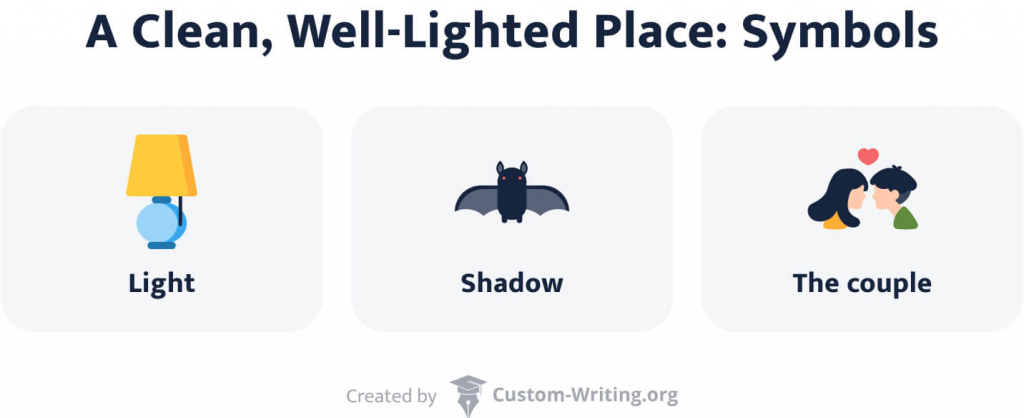Symbolism in A Clean, Well-Lighted Place is crucial in conveying the story’s meaning, since little happens in it plot-wise. According to Prof. Carol Dell’Amico’s analysis, this story is arguably Hemingway’s most minimalist work – instead of elaborate descriptions, it’s all about the subtext:
- The characters often say one thing while implying another.
- The inner monologue of the older waiter describes his moral conflict.
- Even the depiction of the story’s setting– the café – has an underlying meaning.
Custom-Writing.org experts have prepared this page for those who love digging into details. This article analyzes A Clean, Well-Lighted Place‘s symbolism, setting, imagery, and irony. All this information will help you get a better understanding of Hemingway’s short story.
🦄 A Clean, Well-Lighted Place Symbolism
In A Clean, Well-Lighted Place, symbols arise while the writer describes an ordinary situation at a Spanish café. An old man is reluctant to go home, and two waiters have to stay until he leaves.

The central symbol is this café, which the older waiter describes as “a clean, well-lighted place.” It is a temporary refuge from the absurd and meaningless reality. One can preserve dignity and remain authentic there. Everyone needs such a place, which can be anything: a home filled with love or an exciting job.
You do not understand. This is a clean and pleasant café. It is well lighted. The light is very good and also, now, there are shadows of the leaves.
A Clean, Well-Lighted Place, Older waiter
The light and shadow are also full of symbolism in A Clean, Well-Lighted Place.
Light represents life, interaction, safety, and peace of mind. Shadows stand for despair, unwillingness to live, and loneliness. As long as the old man sits in the light, he exists, at least for the two waiters. But when he leaves into the darkness, they’ll forget about him.
Surprisingly, the couple that passes by the café symbolizes loneliness. The woman with an uncovered head is most likely a prostitute. One waiter comments that the guard might pick the soldier up. But the other replies, “What does it matter if he gets what he’s after?” The soldier is lonely, as he decides to spend the night with a person he does not love. The woman is also lonely, even if she does not spend her time with the soldier for money. They use each other to fill in the gaps in their existence.
💡 Did you know?
In a letter to Bernard Berenson that Hemingway wrote in 1952, he commented on one of his works.
“There isn’t any symbolism. The sea is the sea. The old man is the old man… The sharks are sharks, no better, no worse.”
He wrote about reality. His stories are not parables of a wise man. They describe everyday events that we tend to overlook but which tell a lot about human nature. This is what Hemingway’s symbolism is all about.
🗺️ A Clean, Well-Lighted Place Setting
The short story is set in a Spanish café late at night. The time is somewhere before 3 AM, and the season is unknown. Hemingway didn’t specify the year, but we know that he published it in 1933 when the Great Depression was in full swing. The importance of the setting consists in the tone it creates.
🖋️ A Clean, Well-Lighted Place Tone
The story is unhurried, subtle, and matter-of-fact. The author’s opinion on the events is hidden as if he told the story with a straight face and even voice. This technique prevents the readers from superficial reading. After all, the plot is really dull. But if the reader digs into the meaning, it opens up a whole new world of symbolism and philosophical questions.
The style is devoid of any embellishments not to distract us from the details that matter. The only “decoration” is the description of light and shadows in the leaves. Even the epithets of the café (clean and well-lighted) are unartistic.
👀 A Clean, Well-Lighted Place Point of View
The point of view in the short story is third-person omniscient. In other words, none of the characters is used as a point of view. There is a narrator who knows everything. This approach allows Hemingway to create an impartial report of events and conversations. It also gives the reader a feeling of presence: we perceive reality without anyone commenting on it.
When the story reaches its climax and the younger waiter leaves, the older waiter takes the point of view. The narrative is still third-person, but the protagonist merges with the narrator. We hear his thoughts and feel his anguish.
🙃 Irony in A Clean, Well-Lighted Place
There is little to laugh at in the short story. But we can distinguish some ironic moments.
- The first is when the older waiter says that his colleague has everything in life. The younger replies, “You have everything I have.” The dramatic irony is that he is wrong, and the reader knows it.
- Then, the older waiter comes to the bar and, when asked, says he wants “nada.” It is verbal irony meaning that cannot order “nothing.”
- The most prominent example of situational irony is the Lord’s Prayer in the old waiter’s edition. He is going through a depressive episode and should have prayed to God to help him, as a true Christian would do. But he replaces most of the prayer’s text with “nada.” The reader’s expectations fall apart.
- Finally, each person has to find or create a clean, well-lighted place of their own. The ironic paradox is that meaning in this search can be found after one realizes its absence.
Thank you for reading this article! If you need help with formulating a thesis for your paper on A Clean, Well-Lighted Place, try our thesis statement generator. If you are looking for an essay idea on the play, you might want to take a look at the essay topics collection. Any questions left? Check the QA section!





















Concise and authentic information love it. Thank you so much 🥰